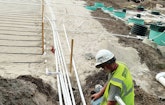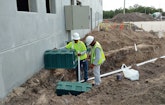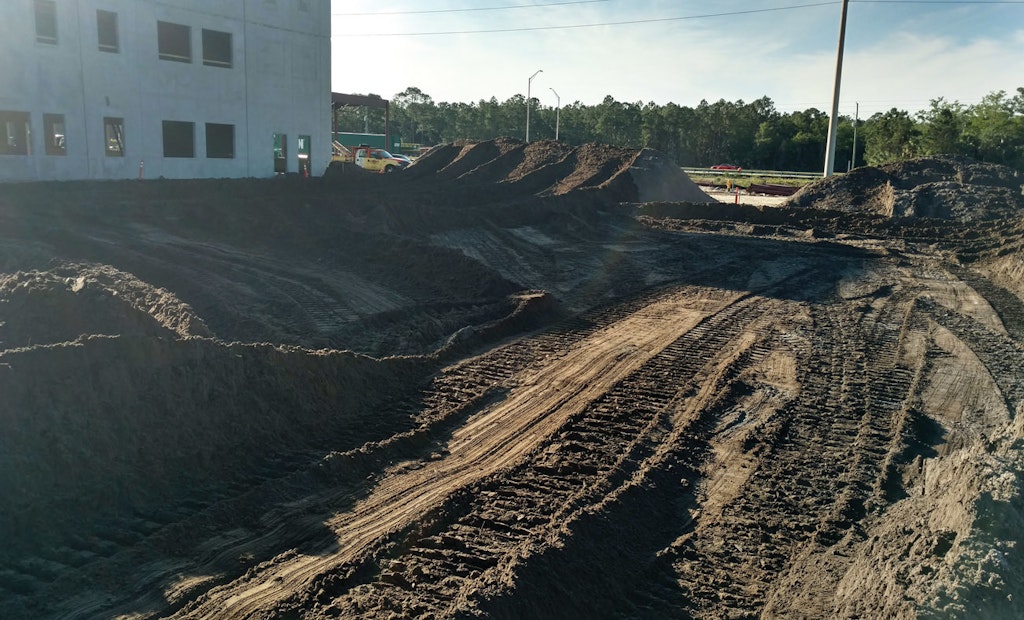Interested in Alarms/Controls?
Get Alarms/Controls articles, news and videos right in your inbox! Sign up now.
Alarms/Controls + Get AlertsStormwater and permitting issues postponed the construction of Collier Charter Academy in Naples, Florida, for a year. As the Red Apple Development design for the K-8 school advanced, the expanding size of the stormwater detention ponds ruled out a conventional septic system with drainfield.
Ryan Cos., the general contractor, hired Greg Mayfield, president of Southern Water and Soil in Zephyrhills, Florida, to design the onsite system. Mayfield proposed a decentralized wastewater denitrification system with drip irrigation — the latter installed under the soccer field. “Package plants have been designed before,” he says. “Our problem was nothing in the code allowed us to use the variance rule to show different flow categories.”
Mayfield’s challenge was convincing the Florida Variance Review and Advisory Committee that a school with 1,145 students would not generate flows greater than 10,000 gpd. “Typical water usage is 15 gpd per student or 17,175 gpd total flow for this system,” he says. “However, Red Apple has designed six comparative schools with low-flow water fixtures and no cafeteria, which reduces water usage to 6 gpd per student or 6,870 gpd total flow for Collier.”
Red Apple’s secret is using Preferred Meals, a company that manufactures preplate frozen meals and distributes them in freezer trucks to be heated and served in individual classrooms. Single-service containers and utensils are discarded. There is nothing to wash up. The committee approved Mayfield’s project 7-0, saving the school $100,000. Obtaining the permit took six months.
Site conditions
Soils are 50 inches of Holopaw fine sand with a loading rate of 0.80 gpd per square foot, and the seasonal high water table is 5 inches below grade. The site is in flatwoods.
System components
Mayfield designed the system to handle 9,000 gpd, but it averages 3,600 gpd. Major components are:
- 5,000-gallon, dual-compartment concrete septic tank (Florida Septic)
- 5,000-gallon surge tank
- Two Biotube pump vaults with PF5005 high-head effluent pumps (Orenco Systems)
- TCOM remote telemetry control panel with drip controllers for four zones (Orenco Systems)
- Three 3,000-gallon 3.0 MicroFAST aerobic treatment units (Bio-Microbics)
- 5,000-gallon dose tank with two PF3007 high-head effluent pumps (Orenco Systems)
- 4,687.5 feet of dripline with ultra headworks (Geoflow)
- TCOM control panel (Orenco Systems)
- Peristaltic metering liquid-chlorine injection pump (Stenner Pump)
System operation
Wastewater flows 30 feet through a 6-inch PVC lateral to the septic tank, then into the surge tank. The tanks are plumbed with 1.5-inch PVC piping. Alternating pumps in the surge tank run for one minute every 20 minutes, sending 50 gallons through a 1-inch ball valve that equalizes the flow to the aerobic treatment units. Liquid chlorine is injected in the treated effluent just before it flows into the dose tank.
Alternating pumps in the dose tank run for 41.5 minutes six times per day, sending 417 gallons to the headworks. Alternating solenoid valves in the headworks direct liquid to one of four zones in the 117-by-83-foot-wide irrigation dripfield. Then 20 percent of dose recirculates to the front of the dose tank since chlorinated water cannot recirculate to the surge tank without killing microorganisms in the FAST units. “We included chlorination to protect students from disease should a dripline break under the soccer field,” Mayfield says.
Installation
Ryan Cos. required all workers to take its 20-minute safety class before going on site. Subcontractor Honc Industries began construction in March 2017.
Honc crews used a Komatsu America PC200LC excavator to dig a 50-by-16-by-14-foot-deep hole for the six tanks set side by side. Drought had lowered the seasonal high water table to 10 feet below grade, resulting in little sloughing during excavation. Nevertheless, when Florida Septic arrived to set the tanks, each placement was done inside a double-wall, steel trench shield from Efficiency Shoring and Supply. “Florida Septic had installed the MicroFAST units at their Hawthorne facility before delivery,” Mayfield says. “All Honc had to do were the excavation and plumbing.”
Sometime after Honc rooted out the saw palmetto shrubs in the 9,375-square-foot area for the absorption bed, the building contractor dumped 2 feet of organic spoil across it. Honc removed the material plus 36 inches of native organic soil, then trucked in 24 inches of washed septic sand. The building contractor used the 50,000 cubic feet of spoil to build berms at the rear of the property. “Honc had huge equipment that moved dump-truck-sized loads of soil at a time,” Mayfield says. “They were highly efficient.”
Since nitrogen is a major concern in Florida, Mayfield elected not to take the 25 percent reduction in drainfield size afforded by secondary treatment. “Incorporating the reduction would have given us a 5,700 gpd system,” he says. “Instead, we wanted more retention time in the FAST units for greater nitrification. That way, we achieve a 60 to 70 percent reduction in nitrogen uptake over leach-through systems during irrigation.” Southern Florida’s climate is mild enough to enable grass to grow year-round.
Maintenance technician Derrick Priset from Southern Water and Soil assisted Honc workers as they installed the 40 driplines, valves and assemblies. Two people cut the tubing exactly 117 feet long, then pulled the length taut at 25 inches on edge. A third person clamped down the line with U-stakes every 10 feet.
Priset also supervised connecting the headworks with its 2-inch vortex filter, automatic filter and field flush valves, return pressure gauge, pressure gauges across the filter, supply flowmeter, and air vent. In the event the state demands higher nitrification achieved only via UV disinfection, Mayfield ran a 1.5-inch PVC pipe from the dose tank to a magnetic flowmeter installed on an outside school wall along with an electrical junction box. “Now we can determine how much water runs through the system, size our UV cabinet accordingly, and tap into the box,” Mayfield says. “Then we take the chlorine offline and return the UV-disinfected water to the surge tank.”
The installation took two weeks and came in under budget because of Honc’s efficiency. The system went online in June 2017.
Maintenance
The Florida Department of Health requires Class D wastewater operators for systems greater than 1,500 gpd. Consequently, the school hired Crews Environmental as the maintenance provider. A technician visits once or twice a week and pulls an effluent sample monthly to test TSS, BOD, and fecal coliform bacteria levels. Mayfield is required to check the system twice a year but feels more comfortable with monthly visits because it is a school.











